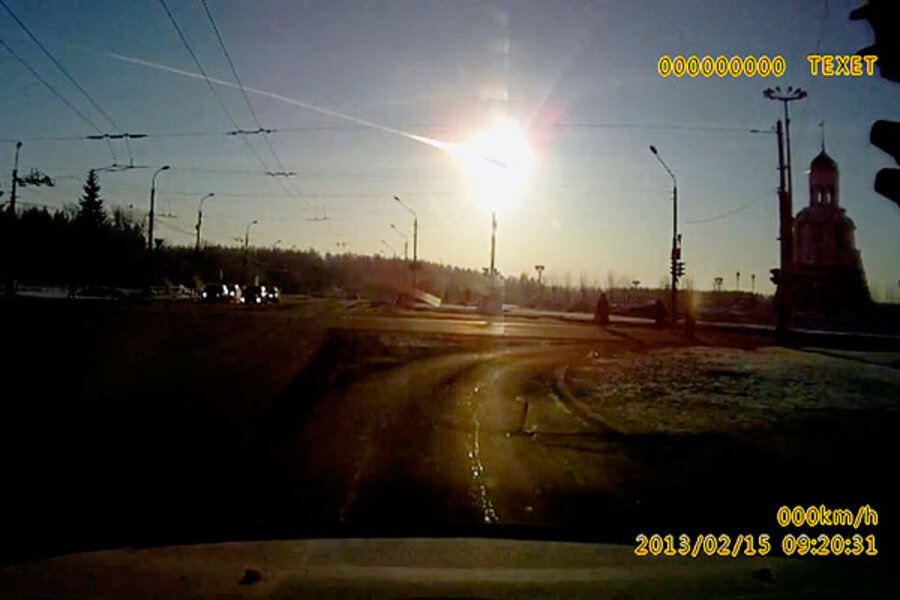Russian meteor blast had force of 300-kiloton nuclear warhead
Loading...
The meteor that exploded over the Ural Mountains in Russia Friday now appears to have been a small asteroid clearly unrelated to 2012 DA14, which flitted past Earth Friday afternoon.
Initially, the Russian Academy of Science estimated the object's mass at about 10 metric tons (11 US tons). With more data in hand, researchers now say the object had a mass of 7,000 metric tons (7,700 US tons) and a diameter of about 50 feet.
The blast released energy comparable to a 300- to 500-kiloton nuclear warhead, says Bill Cooke, who heads the meteoroid environment office at NASA's Marshall Space Flight Center in Hunstville, Ala. By Comparison, the Nagasaki nuclear bomb had a yield of 20 to 22 kilotons.
The asteroid's breakup at an altitude some 12 to 15 miles above Russia's Chelyabinsk region represents the largest recorded asteroid encounter since 1908, when another asteroid or comet exploded over the Tunguska River in Siberia, leveling some 820 square miles of forest, says Paul Chodas, a scientist with the near-Earth object program at NASA's Jet Propulsion Laboratory (JPL) in Pasadena, Calif.
The shock waves from what appear to have been multiple blasts, perhaps triggered as large initial fragments underwent their own disruption, broke windows in the three major cities in the region, including Chelyabinsk. At least 950 people were injured, although most of the injuries were minor, according to reports from the area.
"What an amazing day for near-Earth objects. By an incredible coincidence we have two rare events happening on the very same day," Dr. Chodas said during a briefing Friday afternoon.
Asteroid 2012 DA14 set a record for the closest approach to Earth of an asteroid in its size class humans so far have detected. And the Chelyabinsk blast occurs on average once every hundred years, based on the revised size and mass estimate for the asteroid that triggered it.
The new estimates of the Chelyabinsk asteroid come courtesy of a network of exquisitely sensitive barometers that pick up subtle vibrations in the air at frequencies below the those of human hearing. In effect, they are the atmospheric equivalent of seismographs, which detect earthquakes large and small.
Arrays of these sensors were set up at 60 locations around the world to monitor for violations of the Comprehensive Test Ban Treaty's ban on atmospheric nuclear-weapons tests. Researchers can use the signals these sensors pick up to estimate the energy released in an explosion. That release, in turn, allows for estimates of the asteroid's mass.
Although the Chelyabinsk event probably was recorded by many of the arrays, the new estimates of the asteroid's size and explosive yield came from the four closest arrays, Dr. Cooke of Marshall Space Flight Center says.
Several lines of evidence indicate that the Chelyabinsk asteroid was not a chip off 2012 DA14's block, the two say. The larger, more distant asteroid traversed the sky from south to north at about 17,500 miles an hour. Videos taken of the Chelyabinsk event show the asteroid moving from north to south at 40,000 miles an hour.
By analyzing the direction of the 300-mile-long contrail the Chelyabinsk asteroid left as it passed through the atmosphere, researchers say the object came from the main asteroid belt, which falls between Mars and Jupiter. This belt serves as the source for the asteroids that orbit entirely within the inner solar system, including the near-Earth objects that are the subject of an intense international asteroid hunt to determine which of them may threaten Earth.
Calculations indicate that the Chelyabinsk asteroid's orbit extended as far out as 2.1 astronomical units, or 2.1 times the distance between the Earth and the sun.
When it came in, it did so at a shallow angle and lasted perhaps 30 seconds before it exploded into smaller fragments.
The blast was about four to five times more powerful that an asteroid that exploded over Indonesia in 2009, the researchers say.
The Chelyabinsk asteroid's high-altitude air burst gives some clues to its composition, JPL's Chodas notes. Its breakup at such a high altitude and shallow angle suggests it was not a dense iron-nickel object, but rather a rocky object.
In 1947, the then-Soviet Union was ground zero for a 70-ton metallic meteor, which exploded and broke up over the Sikhote-Alin Mountains in eastern Siberia. Made of sturdier stuff than the Chelyabinsk asteroid, the Sikhote-Alin meteor entered the atmosphere at a much steeper angle and so survived to reach a lower altitude before it exploded. The largest fragments that hit the ground formed craters, while smaller fragments were found embedded in trees.







